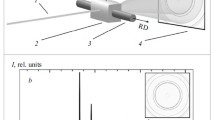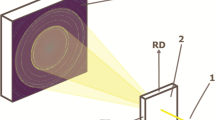Abstract
Cold rolling (CR) leads to a heavy changes in the crystallographic texture and microstructure, especially crystal defects, such as dislocations, and stacking faults increase. The microstructure evolution in commercially pure titanium (cp-Ti) deformed by CR at the room temperature was determined by using the synchrotron peak profile analysis of full width at half maximum (FWHM). The computer program ANIZC has been used for the calculation of diffraction contrast factors of dislocations in elastically anisotropic hexagonal crystals. The dislocation density has a minimum value at 40 pct reduction. The increase of the dislocation density at higher deformation levels is caused by the nucleation of new generation of dislocations from the crystallite grain boundaries. The high-cycle fatigue strength (HCF) has a maximum value at 80 pct reduction and it has a minimum value at 40 pct reduction in the commercially pure titanium.








Similar content being viewed by others
Notes
ANIZC program was developed by Dr. A. Borbely from the University of Budapest, Hungary.
Abbreviations
- RT:
-
Room temperature
- FWHM:
-
Full width at half maximum
- HCF:
-
High-cycle fatigue strength
- CR:
-
Cold rolling
- A 0 :
-
Original area of the cross section
- A d :
-
Cross-sectional area after deformation
- SM:
-
Starting material
- kt:
-
Notch factor
- AL:
-
Bragg reflection
- ALS:
-
Size coefficient
- ADS:
-
Distortion coefficient
- L :
-
Line vector
- g :
-
Diffraction vector
- ε :
-
Strain
- ρ :
-
Density
- b :
-
Burgers vectors
- \( {\bar{C}} \) :
-
Average contrast factor
- F(η):
-
Wilkens function
- Re:
-
Effective outer cut-off radius of dislocations
- λ :
-
X-ray wavelength
- θ :
-
Diffraction angle
- D :
-
Column length of the crystallites
- M :
-
A constant depending on the effective outer cut-off radius of dislocations
References
M. Burlat, D. Julien, M. Lévesque, T. Bui-Quoc, and M. Bernard: Eng. Fract. Mech., 2008, vol. 75, no. 8, pp. 2042-61.
D.L. Rich and L.F. Impellizzeri: Cyclic Stress–Strain and Plastic Deformation Aspects of Fatigue Crack Growth, American Society for Testing and Materials, Philadelphia, PA, 1997, pp. 153–75.
R.W. Hertzberg: Deformation and Fracture Mechanics of Engineering Materials, Wiley, New York, NY, 1996.
V.B. John: Engineering Materials, Macmillan Education Ltd., London, U.K., 1990.
R.C. Picu and A. Majorell: Mater. Sci. Eng. A, 2002, vol. 326, pp. 306-16.
L. Wcislak, H. Klein, H.J. Bunge, U. Garbe, T. Tschentscher, and J.R. Schneider: J. Appl. Crystallogr., 2002, vol. 35, p. 82.
R.W.K. Honeycombe: The Plastic Deformation of Metals, Edward Arnold, London, U.K., 1984, pp. 12-118.
A. Borbely, J. Dragomir-Cernatescu, G. Ribarik, and T. Ungar: J. Appl. Crystallogr., 2003, vol. 36, pp. 160-62.
T. Ungar and G. Tichy: Phys. Status Solidi, 1999, vol. 171, pp. 425-34.
M. Wilkens: Phys. Status Solidi A Appl. Res., 1970, vol. 2, pp. 359–70.
J.A. Simmons, R. de wit, and R. Bullough: Fundamental Aspects of Dislocation Theory, vol. 2 (317), Nat. Bur. Stand. (U.S.) Spec. Publ., 1970, pp. 1195–221.
M.A. Krivoglaz: X-ray and Neutron Diffraction in Nonideal Crystals, Springer, Berlin, 1996, p. 358.
P. Klimanek and R. Kuzel, Jr.: J. Appl. Crystallogr., 1988, vol. 21, pp. 59-66.
R. Kuzel, Jr. and P. Klimanek: J. Appl. Crystallogr., 1988, vol. 21, p. 363.
R. Kuzel, Jr. and P. Klimanek: J. Appl. Crystallogr., 1989, vol. 22, pp. 299-307.
I.C. Dragomir and T. Ungar: J. Appl. Crystallogr., 2002, vol. 35, pp. 556-64.
G.K. Williamson and W.H. Hall: Acta Metall., 1953, vol. 1, pp. 22-31.
M. Wilkens: Phys. Status Solidi, 1970, vol. 2, p. 359.
C. Dragomir, D.S. Li, G.A. Castello-Branco, H. Garmestani, R.L. Snyder, G. Ribarik, and T. Ungar: Mater. Charact., 2005, vol. 55, pp. 66-74.
T. Ungar and A. Borbely: Appl. Phys. Lett., 1996, vol. 69, p. 3173.
A.J.C. Wilson: Il Nuovo Cimento, 1955, vol. 1, no. 2, pp. 277-83.
I. Groma: Phys. Rev. B, 1998, vol. 57, pp. 7535-42.
R.F. Hearmon: Landolt-Börnstein Tables, Group III, K.-H. Hellwege and A.M. Hellwege, Eds., Springer-Verlag, Berlin, Germany, 1979, vol. 11, pp. 1-154.
D. Tromans: IJRRAS, 2011, vol. 6, no. 4, pp. 4-14.
N. Hansen: Mater. Sci. Technol., 1990, vol. 6, no. 11, pp. 1039-47.
T. Ungar, A. Revesz, and A. Borbely: J. Appl. Crystallogr., 1998, vol. 31, pp. 554-58.
Y.B. Chun, S.H. Yu, S.L. Semiatin, and S.K. Hwang: Mater. Sci. Eng. A, 2005, vol. 398, pp. 209-19.
E.P. DeGarmo, J.T. Black, and R.A. Kohser: Materials and Processes in Manufacturing, 9th ed., Wiley, New York, NY, 2003.
G. Ribarik, T. Ungar, and J. Gubicza: J. Appl. Crystallogr., 2001, vol. 34, pp. 669-76.
K. Mathis, K. Nyilas, A. Axt, I.D. Cernatescu, T. Ungar, and P. Lukac:. Acta Mater., 2004, vol. 52, pp. 2889-94.
Z.B. Sajuri, Y. Miyashita, Y. Hosokai, and Y.J. Mutoh: Int. J. Mech. Sci., 2006, vol. 48, pp. 198-209.
L. Wu, A. Jain, D.W. Brown, G.M. Stoica, S.R. Agnew, B. Clausen, D.E. Fielden, and P.K. Liaw: Acta Mater., 2008, vol. 56, pp. 688-95.
S. Suresh: Fatigue of Materials, Cambridge University Press, Cambridge, U.K., 1998.
Z. Deng, L.L. Wang, D. Zhang, J. Liu, C. Liu, and J. Ma: Med. Sci. Monit., 2014, vol. 20, pp. 163-66.
H.W. Höppel, M. Korn, R. Lapovok, and H. Mughrabi: J. Phys. Conf. Ser., 2010, vol. 240, p. 012147.
Acknowledgments
One author (Mr. Alkhazraji) would like to thank the Ministry of Higher Education & Scientific Research, Iraq (MoHESR) and the German Academic Exchange Service (DAAD) for supporting his stay at TU Clausthal.
Author information
Authors and Affiliations
Corresponding author
Additional information
Manuscript submitted November 26, 2013.
Rights and permissions
About this article
Cite this article
ALkhazraji, H., Salih, M.Z., Zhong, Z. et al. Estimation of Dislocation Density in Cold-Rolled Commercially Pure Titanium by Using Synchrotron Diffraction. Metall Mater Trans B 45, 1557–1564 (2014). https://doi.org/10.1007/s11663-014-0066-3
Published:
Issue Date:
DOI: https://doi.org/10.1007/s11663-014-0066-3




